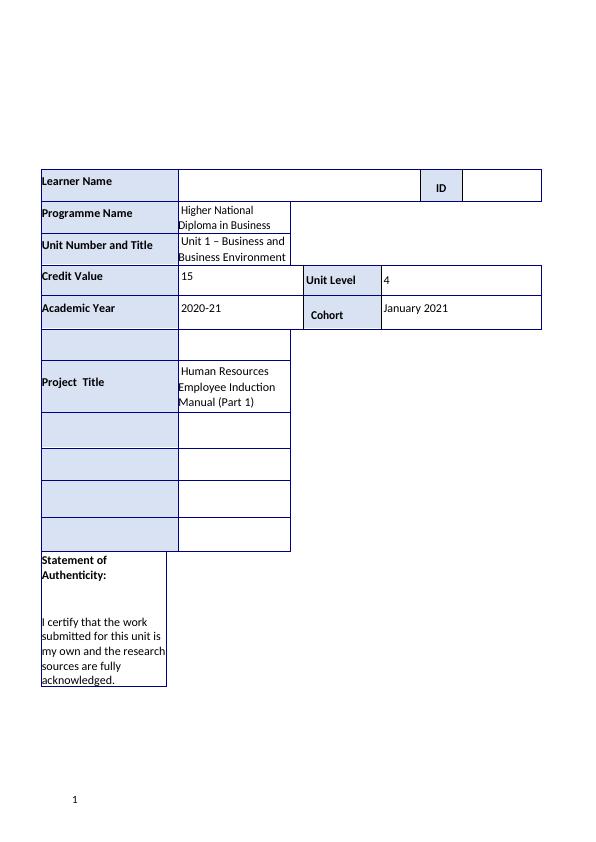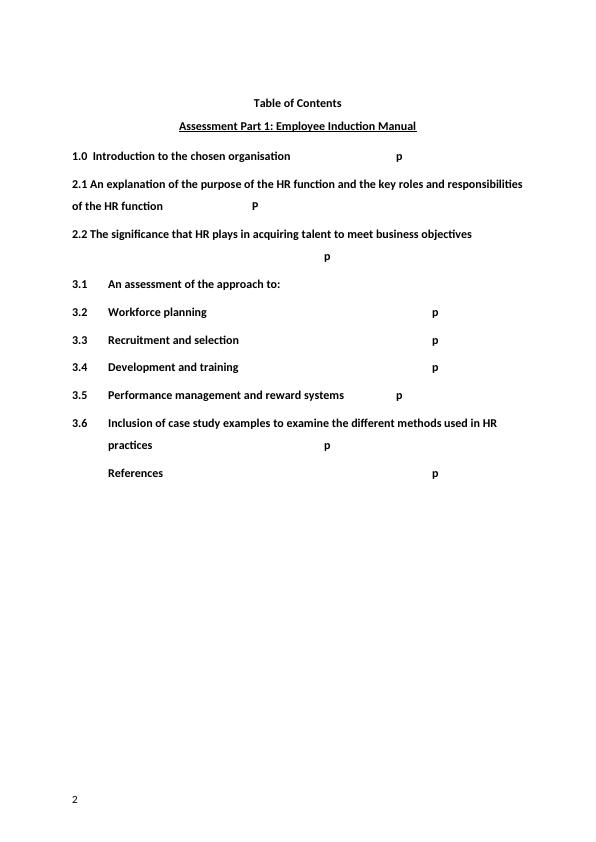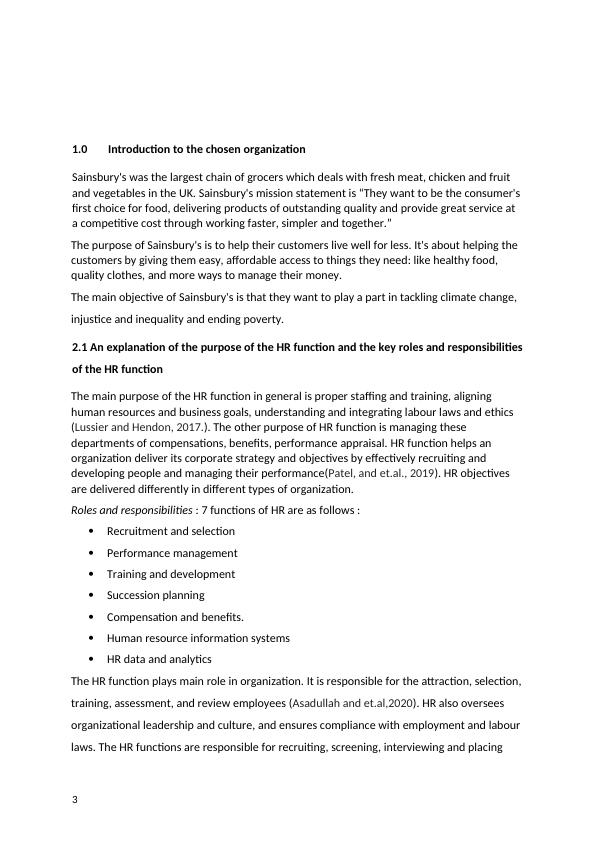Human Resources Employee Induction Manual (Part 1)
Added on 2022-12-15
15 Pages3731 Words155 Views
Learner Name ID
Programme Name Higher National
Diploma in Business
ManagementUnit Number and Title Unit 1 – Business and
Business Environment
Credit Value 15 Unit Level 4
Academic Year 2020-21 Cohort January 2021
Project Title Human Resources
Employee Induction
Manual (Part 1)
Statement of
Authenticity:
I certify that the work
submitted for this unit is
my own and the research
sources are fully
acknowledged.
1
Programme Name Higher National
Diploma in Business
ManagementUnit Number and Title Unit 1 – Business and
Business Environment
Credit Value 15 Unit Level 4
Academic Year 2020-21 Cohort January 2021
Project Title Human Resources
Employee Induction
Manual (Part 1)
Statement of
Authenticity:
I certify that the work
submitted for this unit is
my own and the research
sources are fully
acknowledged.
1

Table of Contents
Assessment Part 1: Employee Induction Manual
1.0 Introduction to the chosen organisation p
2.1 An explanation of the purpose of the HR function and the key roles and responsibilities
of the HR function P
2.2 The significance that HR plays in acquiring talent to meet business objectives
p
3.1 An assessment of the approach to:
3.2 Workforce planning p
3.3 Recruitment and selection p
3.4 Development and training p
3.5 Performance management and reward systems p
3.6 Inclusion of case study examples to examine the different methods used in HR
practices p
References p
2
Assessment Part 1: Employee Induction Manual
1.0 Introduction to the chosen organisation p
2.1 An explanation of the purpose of the HR function and the key roles and responsibilities
of the HR function P
2.2 The significance that HR plays in acquiring talent to meet business objectives
p
3.1 An assessment of the approach to:
3.2 Workforce planning p
3.3 Recruitment and selection p
3.4 Development and training p
3.5 Performance management and reward systems p
3.6 Inclusion of case study examples to examine the different methods used in HR
practices p
References p
2

1.0 Introduction to the chosen organization
Sainsbury's was the largest chain of grocers which deals with fresh meat, chicken and fruit
and vegetables in the UK. Sainsbury's mission statement is “They want to be the consumer's
first choice for food, delivering products of outstanding quality and provide great service at
a competitive cost through working faster, simpler and together.”
The purpose of Sainsbury's is to help their customers live well for less. It's about helping the
customers by giving them easy, affordable access to things they need: like healthy food,
quality clothes, and more ways to manage their money.
The main objective of Sainsbury's is that they want to play a part in tackling climate change,
injustice and inequality and ending poverty.
2.1 An explanation of the purpose of the HR function and the key roles and responsibilities
of the HR function
The main purpose of the HR function in general is proper staffing and training, aligning
human resources and business goals, understanding and integrating labour laws and ethics
(Lussier and Hendon, 2017.). The other purpose of HR function is managing these
departments of compensations, benefits, performance appraisal. HR function helps an
organization deliver its corporate strategy and objectives by effectively recruiting and
developing people and managing their performance(Patel, and et.al., 2019). HR objectives
are delivered differently in different types of organization.
Roles and responsibilities : 7 functions of HR are as follows :
Recruitment and selection
Performance management
Training and development
Succession planning
Compensation and benefits.
Human resource information systems
HR data and analytics
The HR function plays main role in organization. It is responsible for the attraction, selection,
training, assessment, and review employees (Asadullah and et.al,2020). HR also oversees
organizational leadership and culture, and ensures compliance with employment and labour
laws. The HR functions are responsible for recruiting, screening, interviewing and placing
3
Sainsbury's was the largest chain of grocers which deals with fresh meat, chicken and fruit
and vegetables in the UK. Sainsbury's mission statement is “They want to be the consumer's
first choice for food, delivering products of outstanding quality and provide great service at
a competitive cost through working faster, simpler and together.”
The purpose of Sainsbury's is to help their customers live well for less. It's about helping the
customers by giving them easy, affordable access to things they need: like healthy food,
quality clothes, and more ways to manage their money.
The main objective of Sainsbury's is that they want to play a part in tackling climate change,
injustice and inequality and ending poverty.
2.1 An explanation of the purpose of the HR function and the key roles and responsibilities
of the HR function
The main purpose of the HR function in general is proper staffing and training, aligning
human resources and business goals, understanding and integrating labour laws and ethics
(Lussier and Hendon, 2017.). The other purpose of HR function is managing these
departments of compensations, benefits, performance appraisal. HR function helps an
organization deliver its corporate strategy and objectives by effectively recruiting and
developing people and managing their performance(Patel, and et.al., 2019). HR objectives
are delivered differently in different types of organization.
Roles and responsibilities : 7 functions of HR are as follows :
Recruitment and selection
Performance management
Training and development
Succession planning
Compensation and benefits.
Human resource information systems
HR data and analytics
The HR function plays main role in organization. It is responsible for the attraction, selection,
training, assessment, and review employees (Asadullah and et.al,2020). HR also oversees
organizational leadership and culture, and ensures compliance with employment and labour
laws. The HR functions are responsible for recruiting, screening, interviewing and placing
3

workers. The HR functions may also handle employee relations, payroll, benefits, and
training. In Sainsbury's, the roles and responsibilities of HR functions are highly important
because this is very large retail company. The organization constantly requires a motivated
staff which are hired by HR Function for attaining goals and meeting customer needs.
Responsibilities of HR function is as follows:
Managing company staff, including coordinating and supporting the recruitment
process.
On boarding newcomers to the company.
Determining suitable salaries and remuneration.
Providing the necessary support systems for payroll requirements.
Developing adequate induction and training.
Supporting employee opportunities for professional development.
Managing succession planning of staff.
Assisting with the performance management and review process.
2.2 The significance that HR plays in acquiring talent to meet business objectives
HR plays main role in acquiring talent because HR undertakes recruitment procedure. HR
has a huge responsibility of recruiting people on the basis of their talents and which is
identified through talent management(Talent management., 2021). HR managers plays
significant role and responsibility in recruitment process and in the ongoing development of
employee and retention of employee. Talent management is a business strategy that
organization hope will enable them to retain their topmost talented and skilled employees.
If recruitment procedure is effective and proper then, it helps HR in knowing the qualities
and skills of the person (Krishnan and Scullion 2017). It attracts top talented people who are
profitable for the organization. It creates an employer brand that could attract potential
talents, and in turn, contributes to the improvement of the organizations business
performance and results.
HR plays a very significant role in acquiring talent by recruiting those employees who are
going to help in achieving the organizational goals. An effective management helps
4
training. In Sainsbury's, the roles and responsibilities of HR functions are highly important
because this is very large retail company. The organization constantly requires a motivated
staff which are hired by HR Function for attaining goals and meeting customer needs.
Responsibilities of HR function is as follows:
Managing company staff, including coordinating and supporting the recruitment
process.
On boarding newcomers to the company.
Determining suitable salaries and remuneration.
Providing the necessary support systems for payroll requirements.
Developing adequate induction and training.
Supporting employee opportunities for professional development.
Managing succession planning of staff.
Assisting with the performance management and review process.
2.2 The significance that HR plays in acquiring talent to meet business objectives
HR plays main role in acquiring talent because HR undertakes recruitment procedure. HR
has a huge responsibility of recruiting people on the basis of their talents and which is
identified through talent management(Talent management., 2021). HR managers plays
significant role and responsibility in recruitment process and in the ongoing development of
employee and retention of employee. Talent management is a business strategy that
organization hope will enable them to retain their topmost talented and skilled employees.
If recruitment procedure is effective and proper then, it helps HR in knowing the qualities
and skills of the person (Krishnan and Scullion 2017). It attracts top talented people who are
profitable for the organization. It creates an employer brand that could attract potential
talents, and in turn, contributes to the improvement of the organizations business
performance and results.
HR plays a very significant role in acquiring talent by recruiting those employees who are
going to help in achieving the organizational goals. An effective management helps
4

End of preview
Want to access all the pages? Upload your documents or become a member.
Related Documents
Human Resources Employee Induction Manual (Part 1)lg...
|12
|3434
|482
Human Resources Employee Induction Manuallg...
|18
|5259
|53
Human Resources Employee Induction Manual (Part 1) - The Job Application (Part 2)lg...
|16
|4423
|390
Human Resources Employee Induction Manual (Part 1)lg...
|13
|3425
|116
Human Resources Employee Induction Manual (Part 1)lg...
|16
|4125
|165
Human Resources Employee Induction Manual (Part 1) - Deskliblg...
|21
|5026
|103
